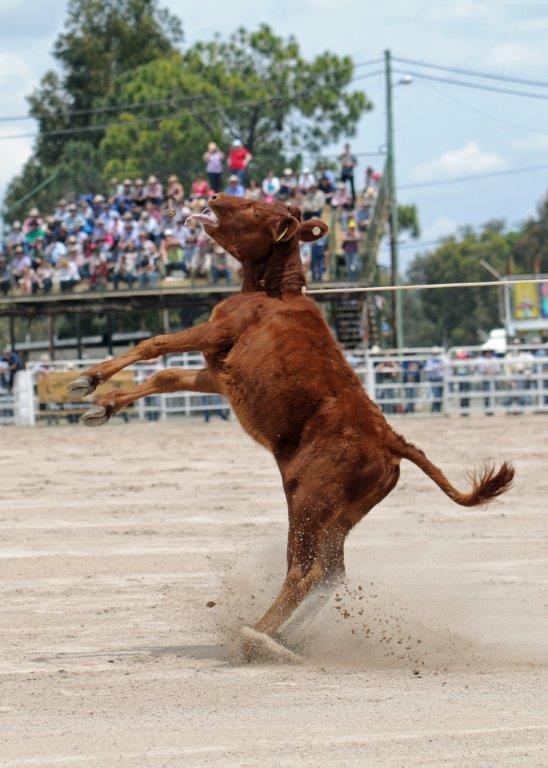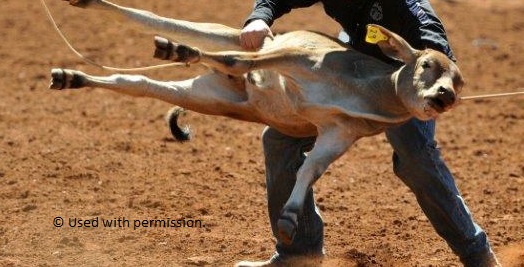Although all rodeo events pose significant risks, calf roping (also known as rope-and-tie) raises particularly serious concerns. Calf roping involves releasing the young animal ahead of the competitor/roper who is on horseback. The rider will chase and lasso the calf by throwing a rope over the calf’s neck. The contestant then dismounts and runs to the animal, relying on their horse to keep the calf from running by maintaining tension on the rope. After catching the animal, the rider forces the calf to the ground to then tie three of the calf’s legs with rope.
The risks of injury to the young animal due to calf roping include:
- damage to the windpipe and soft tissues of the neck due to being suddenly jerked in a different direction to which the calf is running
- bruising and broken ribs as the young animal is forced to the ground
- choking from being dragged along the ground.


Calves experience pain and/or fear when being choked, yanked off their feet, thrown, and leg tied. Prey species (e.g. cattle) tend to hide fear and pain so as to avoid drawing attention of predators, which is a survival instinct. Thus, when a calf bellows and shows other signs of fear, pain or stress, this indicates significant suffering.
Signs of fear and/or stress in rodeo calves
The following infographic depicts different behaviours, body language and facial expressions shown by a calf who is experiencing fear and/or stress compared to a contented calf.

It is also not uncommon for calves to be mis-roped, where the rope lassoes a part of the body, and not the neck; this may include the rope lassoing the calf’s head, across their eyes and nose or around their legs. These incidents can cause bruising and abrasions, as well as posing a serious risk of causing bone fractures to the calf. Under current rodeo rules, competitors are generally not disqualified for mis-roping calves but are permitted to continue with the event. Thus, there is no penalty for competitors who do not complete the task properly and cause distress and potential injury to calves. When a calf is mis-roped, immediate assistance by arena officials to the competitor to remove the rope from the calf as quickly as possible would reduce risks to the calf.
The following video footage of calf roping has been provided with permission and shows ‘eye white’, bellowing, mouth gaping and tongue lolling, which demonstrates the pain and/or fear experienced by these young vulnerable animals. Warning: this footage is graphic.
The natural response of a calf to being separated from other calves and chased by a ‘predator’ is fear and this causes stress to the young animal. A 2015 study undertaken in Queensland demonstrated that calves showed elevated stress hormone levels in the blood after being roped [1]. The same study also found that calves who had never been exposed to a holding pen or chute had increased stress hormones after they had been marshalled and moved across the arena by a rider on horseback. All calves in the study also showed ‘eye white’, where the calf’s eye rolls to reveal about 50% of the white of the eye, and they also ran faster during roping in an attempt to flee the chasing rider. ‘Eye white’ is believed to be a behavioural response to shut out environmental input which may be overwhelming for the calf to see.
A study by the University of Sydney, published in 2023, analysed video footage which identified behaviours commonly associated with signs of fear and distress displayed by calves being roped [2]. Calves tried to escape the horse and rider as well as resisting being caught and restrained, and struggled to get up even when their legs were tied. Bellowing was also evident when calves were lassoed and caught.
The results of this study are consistent with findings from a previous study which used images of calves before and after being roped in rodeos [3]. Observers, who were blinded to the context of the images, scored each photograph against descriptive terms relating to the emotions the calves might be experiencing. During the chase phase, after the calves had been released from the chute, observers judged the calves were more agitated, stressed, frightened and anxious than they were immediately after the ropes were released.
A previous study of 30 rodeo calves also showed increased stress hormone levels in calves, including those who had been chased but not successfully lassoed, compared to levels in calves who were present but not used for roping [4].
A review by the New Zealand National Animal Welfare Advisory Committee concluded that calf rope-and-tie events raise serious concerns as they regularly cause negative impacts, and potentially quite substantial impacts [5].
Animal welfare organisations around the world oppose the cruelty inflicted on animals used in rodeos. The Australian Veterinary Association does not support calf rope-and-tie events due to significant animal welfare concerns [6].
The Ropersmate™ Roping Device is claimed by the rodeo industry to act as a shock absorber, to lessen the force experienced by both the horse and calf. However, these claims are based on a benchtop assessment using an inanimate object. Despite using this device, calves continue to be yanked violently off their feet with the force concentrated on the sensitive neck tissues. Without a comprehensive investigative study, claims regarding improved welfare by using the Ropersmate™ Roping Device are regarded as speculative.
Calf roping is effectively banned in two states, Victoria and South Australia, through a mandated minimum body weight of 200 kg for cattle used in rodeos. In other states, calves as light as 100 kg can be used for roping and there are no laws prohibiting the use of unweaned or recently weaned calves. A recently published paper highlights the inconsistencies in regulation of calf roping between Australian jurisdictions [7]. The authors concluded that calf roping causes unnecessary harm which raises concerns regarding the adequacy of legal protection for calves in jurisdictions where calf roping is permitted. There are ongoing efforts by the RSPCA and other advocacy groups to change the legislation so that all jurisdictions mandate a minimum body weight of 200 kg for cattle used in rodeos or alternatively prohibit the event.
Another form of calf roping, which is mainly confined to female competitors, is called breakaway roping. In this event calves are chased and roped around the neck, then the rope is released to allow the calf to continue running to leave the arena. Studies examining the impact of roping on calves show that calves experience fear and stress due to being chased by a horse and rider [3,4]. Consequently, this event, which may appear to be less aversive, is also likely to cause fear and stress to calves.
Community concerns
In 2023, of the 1505 Australians who were surveyed by an independent company, 61% were concerned about the welfare impacts of calf roping and supported a ban on calf roping, with 45% being less likely to support a business who sponsored a rodeo.
What you can do
Calf roping results in unacceptable animal welfare compromise and risk of injury to calves, simply for the sake of entertainment. Laws need to be changed in states and territories that still allow calf roping in order to put a stop to this distressing event. Only a small proportion of the population attend or participate in rodeos and the many members of the public would be unaware of the suffering endured by animals at these events. The RSPCA is opposed to rodeos and rodeo schools because of the potential for significant injury, suffering or distress to the animals involved. Rodeos are held in all states and territories in Australia except for the Australian Capital Territory where they are prohibited. You can help stop rodeos by raising awareness of the risks to animals inherent in all rodeo events (particularly calf roping), especially if a rodeo is held in your local community. You can also meet with your local member of Parliament and write to the Minister responsible for animal welfare in your state or territory to urge calf roping to cease.
Relevant podcast
https://open.spotify.com/episode/5tkF75s2bMSJc3VxA2zCHn?si=6Q7rihmBRkqW5vjK8pNAnA
References
[1] Sinclair M, Keeley T, Lefebvre A, Phillips C. Behavioural and physiological responses of calves to marshalling and roping in a simulated rodeo event. Animals. 2016,6(30).
[2] Dixon S, Evans D, Vindevoghel T, Ward MP, Quain A. Behaviours expressed by rodeo calves during different phases of roping. Animals. 2023,13(343) https://doi.org/10.3390/ani13030343
[3] Rizzuto, S., Evans D, Wilson B, McGreevy P. Exploring the use of a Qualitative Behavioural Assessment approach to assess emotional state of calves in rodeos. Animals. 2020,10(1) 113 https://doi.org/10.3390/ani10010113.
[4] Fisher MW, Deaker JM, Fisher RE, Kemp FE. The effects of roping on the behaviour and physiology of calves in a rodeo. 2003 In Report to Ministry of Agriculture and Forestry; Kotare Bioethics Ltd.: Hastings, New Zealand.
[5] New Zealand National Animal Welfare Advisory Committee (2018) Rodeo events – How do they impact the sentient animal? Assessing the animal welfare impacts that rodeo events may have, through a five domains of animal welfare approach.
[6] Australian Veterinary Association (2023) Welfare of animals used in rodeos. Rodeos (ava.com.au)
[7] Stonebridge M, Evans D, Kotzmann J. Sentience matters: Analysing the regulation of calf-roping in Australia. Animals. 2022,12(1071), https://doi.org/10.3390/ani12091071.
